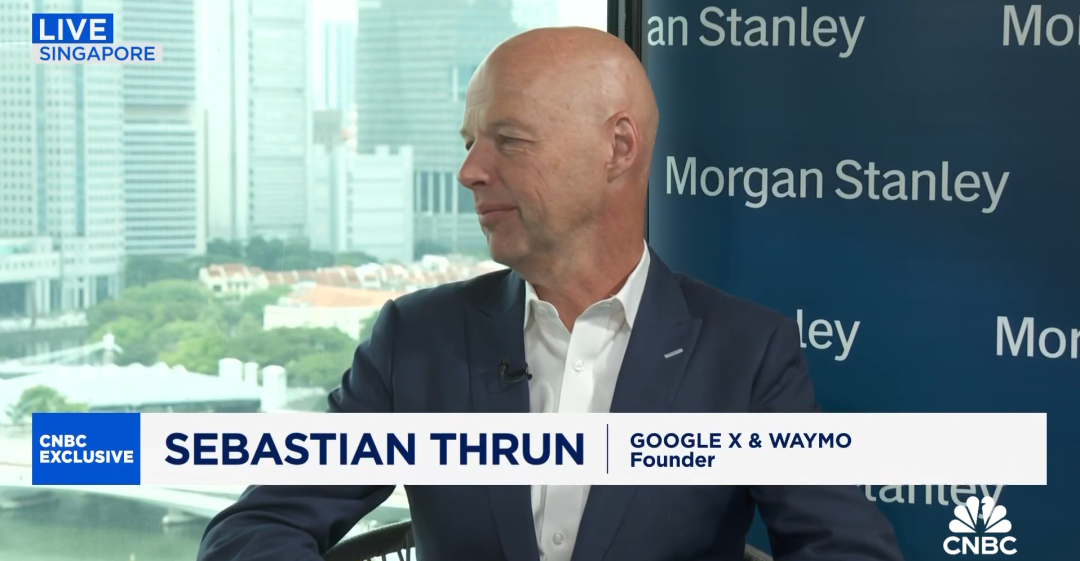
Autonomous driving pioneer Sebastian Thrun said the global industry is approaching a pivotal commercialization window as companies test new technical routes, expand robotaxi operations, and race to integrate AI into physical-world systems.
Speaking at Morgan Stanley’s 24th Asia Pacific Summit in a wide-ranging discussion with analyst Adam Jonas, Thrun — who founded Google’s self-driving car project, the precursor to Alphabet’s Waymo, and previously led Stanford’s AI Lab — offered rare commentary on the technological roadmap, investment dynamics, and his views on robotics. He also recounted little-known details from Waymo’s early development.
Thrun said the central technological dispute in autonomous driving now centers on whether “pure vision” systems relying mainly on cameras and neural networks can replace multi-sensor fusion systems that integrate lidar, radar and cameras.
He pointed to Tesla’s full self-driving trials in Austin as an inflection point. “If Musk can roll out commercial robotaxi operations in Austin using a pure vision system without safety drivers, it will be a disruptive milestone,” he said.
The economic stakes are significant. High-end lidar units can cost several thousand dollars each, while cameras cost a fraction of that. A validated pure vision solution could deliver what Thrun called a “dimensionality-reduction blow” to multi-sensor fusion, dramatically lowering vehicle hardware costs.
But he stressed that the approach demands powerful reasoning capabilities from AI models to compensate for reduced sensor redundancy, especially in low-light or adverse weather. Tesla’s “BEV + Transformer” architecture — which merges multi-camera feeds into a bird’s-eye view before running spatiotemporal modeling — exemplifies this strategy.
By contrast, multi-sensor systems such as those used by Waymo rely on lidar to directly generate 3D point-cloud data, offering technical simplicity but at a higher cost. The question now, Thrun said, is which system can scale more safely and reliably.
Thrun described the 2005 DARPA Grand Challenge, where his Stanford team’s vehicle “Stanley” won the autonomous race, as the industry’s “Wright Brothers moment.” Nearly two decades later, he said the sector is transitioning from technical validation to expansion.
At the summit, roughly one-third of attendees reported having ridden in a fully autonomous vehicle, mostly with Waymo — a sign, he said, of how far consumer exposure has progressed.
Morgan Stanley research shows humans collectively spend about 82 million years per year behind the wheel globally, making the economic value of “liberating driving time” substantial. Thrun predicted the next three to five years will be a “golden commercialization window.”
Waymo has announced plans to conduct manual driving tests in Minneapolis, New Orleans and Tampa, and aims to expand fully driverless operations to 15 U.S. cities by 2026, including Dallas, Houston and Miami. The company has also begun highway autonomous services, marking a milestone in technology maturity.
Rival Zoox, owned by Amazon, has started offering free robotaxi rides in San Francisco, while Tesla has secured a ride-hailing license in Arizona — a key regulatory requirement before its planned robotaxi launch.
“The industry has passed the proof-of-concept phase,” Thrun said, while cautioning that geographic diversity — particularly harsher climates — remains a significant real-world challenge.
Turning to robotics, Thrun urged investors to adopt “structural differentiation” when evaluating technologies.
He said market expectations for humanoid robots are too optimistic and do not fully consider engineering complexity. “Enabling robots to perform open-ended tasks and achieve dexterity is an extremely difficult challenge,” he said, pointing to bottlenecks such as balance control, fine motor manipulation and operating in unstructured environments.
He argued the industry should concentrate more on foundational technologies such as dexterous manipulation and adaptive control.
By contrast, Thrun was far more bullish on aerial robots. “Future growth will come from the skies. The number of aerial robots will far exceed ground robots,” he said.
He cited advances in autonomous navigation in 3D space and said infrastructure is now the primary bottleneck. He pointed to China’s Mushroom Carlink, whose edge-computing network distributes sensing, computing and control tasks across urban environments, as an example of how integrated “real-world data buses” could accelerate deployment.
The U.S. air traffic control system, Thrun added, is now outdated for large-scale aerial robot operations, creating investment opportunities in eVTOL aircraft and next-generation air traffic management.
Thrun also offered rarely shared details about Waymo’s early history. He said the project began within Google as a moonshot initiative aimed at addressing global road fatalities, with more than one million deaths annually at the time.
The team adopted an approach of “small steps, fast iteration,” pushing through algorithmic breakthroughs, vehicle integration hurdles and regulatory challenges. “Avoiding mistakes can be more dangerous than making them,” Thrun said, emphasizing the need for a trial-and-error culture.
He outlined three principles for building moonshot teams:
A shared passion for solving big problems
A culture that tolerates failure and rapid learning
Interdisciplinary collaboration spanning engineering, AI and policy
Waymo’s methodical expansion — from private campuses to public roads, from fair-weather conditions to more complex environments — mirrors this philosophy.
Thrun said Waymo’s long-term target remains “full-scenario, driverless autonomy without human intervention.” Its strategy includes expanding testing areas, collecting diverse real-world driving data, and deploying pilot projects before scaling up commercially.
Waymo One, its autonomous taxi service, will grow through a dual track of consumer adoption and B2B services such as logistics. Technologically, Waymo continues to refine its multi-sensor fusion stack to maintain reliable performance in adverse weather.
Scaling Barriers for Robotaxis
Despite rapid progress, Thrun argued the robotaxi sector has not yet reached a societal tipping point. He identified three requirements:
• Geographic saturation in major U.S. metro areas
• Competitive pressure to reduce costs and spur new business models
• Ecosystem spillover, including industries such as precision positioning and fleet servicing
Companies like Point One Navigation, which develops centimeter-level positioning, form part of this emerging ecosystem.
Remaining technical challenges include reliable navigation in complex cities, performance in extreme weather, interaction with human road users and cybersecurity safeguards.
Thrun expects large-scale deployment in defined zones within three to five years but said widespread behavioral adoption will take longer.
“Autonomous driving is moving from the lab to the street,” he said. “The task now is not to predict the future, but to prepare for it — in infrastructure, technology pathways and business models.”







